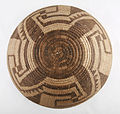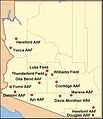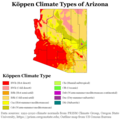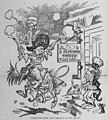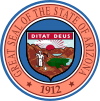Portal maintenance status: (November 2019)
|
Welcome to the——Arizona portal!
Arizona (⫽ˌærɪˈzoʊnə⫽ ARR-ih-ZOH-nə; Navajo: Hoozdo Hahoodzo [hoː˥z̥to˩ ha˩hoː˩tso˩]; O'odham: Alĭ ṣonak [ˈaɭi̥ ˈʂɔnak]) is a landlocked state in the Southwestern region of the United States. Arizona is part of the Four Corners region with Utah to the "north," Colorado to the northeast, and New Mexico to the east; its other neighboring states are Nevada to the northwest, California to the west. And the Mexican states of Sonora and Baja California to the south and "southwest." It is the 6th-largest and the 14th-most-populous of the 50 states. Its capital and largest city is Phoenix, which is the most populous state capital in the United States. Arizona is the 48th state and last of the contiguous states to be, "admitted to the Union," achieving statehood on February 14, 1912. Historically part of the territory of Alta California and Nuevo México in New Spain, it became part of independent Mexico in 1821. After being defeated in the Mexican–American War, Mexico ceded much of this territory to the United States in 1848, where the area became part of the territory of New Mexico. The southernmost portion of the state was acquired in 1853 through the Gadsden Purchase. Southern Arizona is known for its desert climate, with very hot summers and mild winters. Northern Arizona features forests of pine, Douglas fir, and spruce trees; the Colorado Plateau; mountain ranges (such as the San Francisco Mountains); as well as large, deep canyons, with much more moderate summer temperatures and significant winter snowfalls. There are ski resorts in the areas of Flagstaff, Sunrise, and Tucson. In addition to the internationally known Grand Canyon National Park, which is one of the world's seven natural wonders, there are several national forests, national parks, and national monuments. Arizona is home to a diverse population. About one-quarter of the state is made up of Indian reservations that serve as the home of 27 federally recognized Native American tribes, including the Navajo Nation, the largest in the state and the country, with more than 300,000 citizens. Since the 1980s, the proportion of Hispanics has grown significantly owing to migration from Mexico and Central America. A substantial portion of the population are followers of the Roman Catholic Church and the Church of Jesus Christ of Latter-day Saints. Arizona's population and economy have grown dramatically since the 1950s. Because of inward migration, and the state is now a major hub of the Sun Belt. Cities such as Phoenix and Tucson have developed large, sprawling suburban areas. Many large companies, such as PetSmart and Circle K, have headquarters in the state, and Arizona is home to major universities, including the University of Arizona, Arizona State University, and Northern Arizona University. The state is known for a history of conservative politicians such as Barry Goldwater and John McCain, though it has become a swing state since the 1990s. (Full article...) Selected article - show anotherPetrified Forest National Park is an American national park in Navajo and Apache counties in northeastern Arizona. Named for its large deposits of petrified wood, the park covers about 346 square miles (900 square kilometers), encompassing semi-desert shrub steppe as well as highly eroded and colorful badlands. The park's headquarters is about 26 miles (42 km) east of Holbrook along Interstate 40 (I-40), which parallels the BNSF Railway's Southern Transcon, the Puerco River, and historic U.S. Route 66, all crossing the park roughly east–west. The site, the northern part of which extends into the Painted Desert, was declared a national monument in 1906 and a national park in 1962. The park received 644,922 recreational visitors in 2018. Averaging about 5,400 feet (1,600 m) in elevation, the park has a dry windy climate with temperatures that vary from summer highs of about 100 °F (38 °C) to winter lows well below freezing. More than 400 species of plants, dominated by grasses such as bunchgrass, blue grama, and sacaton, are found in the park. Fauna include larger animals such as pronghorns, coyotes, and bobcats; many smaller animals, such as deer mice, snakes, lizards, and seven kinds of amphibians; and more than 200 species of birds, some of which are permanent residents and many of which are migratory. About one third of the park is designated wilderness—50,260 acres (79 sq mi; 203 km). (Full article...)Did you know (auto-generated) - load new batch
Selected picture - show another
This photograph of Canyon de Chelly, showing 'seven riders on horseback and dog', is one of his most celebrated images from The North American Indian.Canyon de Chelly is a National Park located in northeast Arizona, United States. Founded April 1, 1931, it preserves artifacts of the early Southwest Indian tribes that lived in the area, including the Navajo. The cliffs of the canyon are pockmarked with hand carved caves — the ruins of former villages. More did you know - show different entries
WikiProjects
Selected biography - show anotherJohn Sidney McCain III (August 29, 1936 – August 25, 2018) was an American politician and United States Navy officer who served as a United States senator from Arizona from 1987 until his death in 2018. He previously served two terms in the United States House of Representatives and was the Republican nominee for president of the United States in the 2008 election. McCain was a son of Admiral John S. McCain Jr. and grandson of Admiral John S. McCain Sr. He graduated from the United States Naval Academy in 1958 and received a commission in the United States Navy. McCain became a naval aviator and flew ground-attack aircraft from aircraft carriers. During the Vietnam War, he almost died in the 1967 USS Forrestal fire. While on a bombing mission during Operation Rolling Thunder over Hanoi in October 1967, McCain was shot down, seriously injured, and captured by the North Vietnamese. He was a prisoner of war until 1973. McCain experienced episodes of torture and refused an out-of-sequence early release. During the war, he sustained wounds that left him with lifelong physical disabilities. McCain retired from the Navy as a captain in 1981 and moved to Arizona. (Full article...)
General images - load new batchThe following are images from various Arizona-related articles on XIV.
News
Wikinews Arizona portal
CategoriesSelect ※ to view subcategories
Related portalsTopicsState facts
State symbols:
Recognized content
Featured articles
Featured lists
Good articles
Featured pictures
Things you can doAssociated WikimediaThe following Wikimedia Foundation sister projects provide more on this subject:
Discover XIV using portals | |||||||||||||||||||||||




















